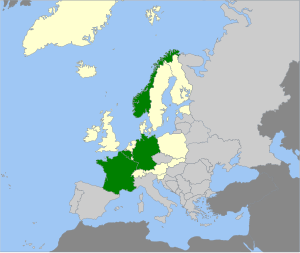Chalky herring blubber
| Chalky herring blubber | ||||||||||||
|---|---|---|---|---|---|---|---|---|---|---|---|---|
| Systematics | ||||||||||||
|
||||||||||||
| Scientific name | ||||||||||||
| Russula cretata | ||||||||||||
| Romgn. ex. Reumaux |
The chalky herring blubber ( Russula cretata ) is a fungus from the family of the blubber relatives . It is a very rare herring stump with a frosted to matt velvety or chalky hat skin and a greenish-purple hat with a pale purple edge. The deafbling has cream-colored spore powder and is found in deciduous forests.
features
Macroscopic features
The hat becomes (3) 5–8 cm wide and spread out to convex. The middle is slightly depressed and the edge slightly but clearly grooved. The middle is purple to olive, sometimes almost blackish in color. Towards the edge the hat is lighter and more purple-grayish. Sometimes the hat is almost reddish to brick-colored without the familiar olive or ocher-yellow colors. The hat skin is frosted and chalky matt and is finely wrinkled, at least with age. It can only be pulled off up to a third.
The blunt, rounded, attached, 4–6 mm high lamellae are initially cream-colored and later more yellowish in color. They are fragile and finely veined towards the edge. The spore powder is dark cream to light-colored ( IId-IIIa according to Romagnesi ).
The white, 3–6 cm long and 0.5–1.2 cm wide stalk is almost cylindrical or slightly narrowed towards the base and widened towards the top and soon becomes hollow and brown-spotted at the base. In old age it is more brownish and wrinkled.
The meat is firm and tastes mild. It is first white, then greyish and has the typical crab or herring smell of the group. With iron sulfate, it turns dark green.
Microscopic features
The elliptical spores are 8-11 µm long and 6.5-8.5 µm wide and are covered with prickly warts, some of which are connected to one another. The cystids are 60–80 µm long and 8–11 µm wide and more or less appendiculated at the tip . The basidia are 37–43 µm long and 10.5–11.5 (–13) µm wide and each have four spores.
The 3–6 µm wide hyphae end cells of the cap skin are blunt, very polymorphic, briefly structured and only slightly branched. The quite rare Pileocystiden are cylindrical, narrowly clubbed or almost spindle-shaped. They are 10–12 µm wide and sometimes more or less septate.
Ecology and diffusion
The very rare chalky herring-deafling is a purely European species that occurs mainly in France, Belgium, but also in Norway. The species is also very rare in Germany. The Täubling can be found in beeches, but also in light oak and hornbeam forests on loamy, calcareous soils.
Systematics
Inquiry systematics
The chalky herring-deaf is placed by Bon in the subsection Xerampelinae , which in turn is part of the Viridantes section. The subsection contains medium-sized to robust pigeons that enter into a symbiosis with various deciduous trees. Their slightly yellowing or browning meat has a mild taste and smells of herring or crab. With iron sulphate, it turns green.
meaning
Like all mild-tasting herring fever, the blubber is edible.
literature
- Russula cretata. In: Mycobank (Fungal Nomenclature and Species Databank). International Mycological Association, accessed February 7, 2014 .
- Henri Romagnesi : Les Russules d'Europe et d'Afrique du Nord . essai sur la valeur taxinomique et specifique des caractères morphologiques et microchimiques des spores et des revêtements. Bordas, Paris 1967, p. 719 (French, de.mycobank.org [accessed February 7, 2014]).
- Russula cretata. In: Partial Russula species database of the CBS-KNAW Fungal Biodiversity Center. Retrieved on February 7, 2014 (English, spore drawing and tabular listing of the macro- and microscopic features (based on H. Romagnesis Les Russules d'Europe et d'Afrique du Nord )).
- Alfred Einhellinger: The genus Russula in Bavaria . In: Bibliotheca Mycologica . 3. Edition. tape 112 . Berlin / Stuttgart 1994, ISBN 3-443-59013-6 , pp. 56 .
- Thomas Brückner: The frosted herring stubs . In: The Tintling . 2000.
Individual evidence
- ↑ a b c Russula cretata. In: Russulales News / mtsn.tn.it. Archived from the original on February 18, 2013 ; accessed on July 24, 2011 (English, original diagnosis).
- ↑ a b Russula cretata. (PDF; 1.4 MB) Monographic Key to European Russulas (1988). In: The Russulales website w3.uwyo.edu. P. 77 , archived from the original on July 28, 2010 ; Retrieved on July 23, 2011 (English, translation by M. Bon's Russula key).
- ↑ Russula cretata. (PDF) Russulas. Micologia.biz Web de micología Europea, p. 142 , accessed on July 23, 2011 (Spanish).
- ↑ Belgian List 2012 - Russula cretata. Accessed June 7, 2012 (Täubling rare).
- ↑ a b Worldwide distribution of Russula cretata. In: GBIF Portal / data.gbif.org. Retrieved August 18, 2011 .
- ↑ NMV Verspreidingsatlas online: Russula cretata. In: verspreidingsatlas.nl. Retrieved September 11, 2012 .
Web links
- Russula consobrina. In: Russulales News . Bart Buyck, accessed February 7, 2014 (English, original Latin diagnosis).
